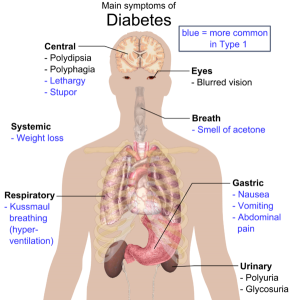Hospitalized COVID-19 patients have a greater risk of dying if they are men or if they are obese or have complications from diabetes or hypertension, according to a new study conducted by University of Maryland School of Medicine (UMSOM) researchers. In a study published in the journal Clinical Infectious Diseases, the researchers evaluated nearly 67,000 hospitalized COVID-19 patients in 613 hospitals across the country to determine the link between certain common patient characteristics and the risk of dying from COVID-19.

Public domain image/Mikael Häggström
Their analysis found that men had a 30 percent higher risk of dying compared to women of the same age and health status. Hospitalized patients who were obese, had hypertension or poorly managed diabetes had a higher risk of dying compared to those who did not have these conditions. Those aged 20 to 39 with these conditions had the biggest difference in their risk of dying compared to their healthier peers.
“Predicting which hospitalized COVID-19 patients have the highest risk of dying has taken on urgent importance as cases and hospitalizations in the U.S. continue to surge to record high numbers during the month of December,” said study corresponding author Anthony D. Harris, MD, MPH, Professor of Epidemiology and Public Health at UMSOM. “Knowledge is power in many ways, so I think understanding which hospitalized COVID-19 patients are at highest risk of mortality can help guide difficult treatment decisions.”
For example, higher-risk patients may be given the drug remdesivir earlier in their hospitalization to help prevent severe complications or may be considered for closer monitoring or ICU admission. Healthcare providers may also want to consider these risks when determining which COVID-19 patients could benefit the most from the new monoclonal antibody therapies that, if given in the first few days of the infection, can reduce the risk of hospitalization.
Age remained the strongest predictor of mortality from COVID-19. Overall, nearly 19 percent of hospitalized COVID-19 patients died from their infection with the lowest mortality among pediatric patients, which was less than 2 percent. Mortality rates increased with each decade of life with the highest mortality, 34 percent, among those aged 80 and older.
“Older patients still have the highest risk of dying, but younger patients with obesity or hypertension have the highest risk of dying relative to other patients their age without these conditions,” said study lead author Katherine E. Goodman, JD, PhD, a postdoctoral fellow in the Department of Epidemiology and Public Health at UMSOM. “Doctors may want to be paying extra attention to these younger patients when they’re hospitalized to ensure they detect any complications quickly.”
The researchers also found some good news in their study findings. Death rates among hospitalized patients have fallen dramatically since the early weeks of the pandemic in April. This is likely due to the availability of new treatments and more knowledge in the medical community on how to properly manage and care for hospitalized patients.
“As we head into what may be the darkest weeks of the pandemic, it is reassuring to know that our researchers are continuing to make important advances that could help guide the decision-making skills of healthcare workers in the field,” said E. Albert Reece, MD, PhD, MBA, Executive Vice President for Medical Affairs, UM Baltimore, and the John Z. and Akiko K. Bowers Distinguished Professor and Dean, University of Maryland School of Medicine. “I am incredibly proud of our faculty and what they have accomplished to help save the lives of COVID-19 patients as we eagerly await a vaccine.”

